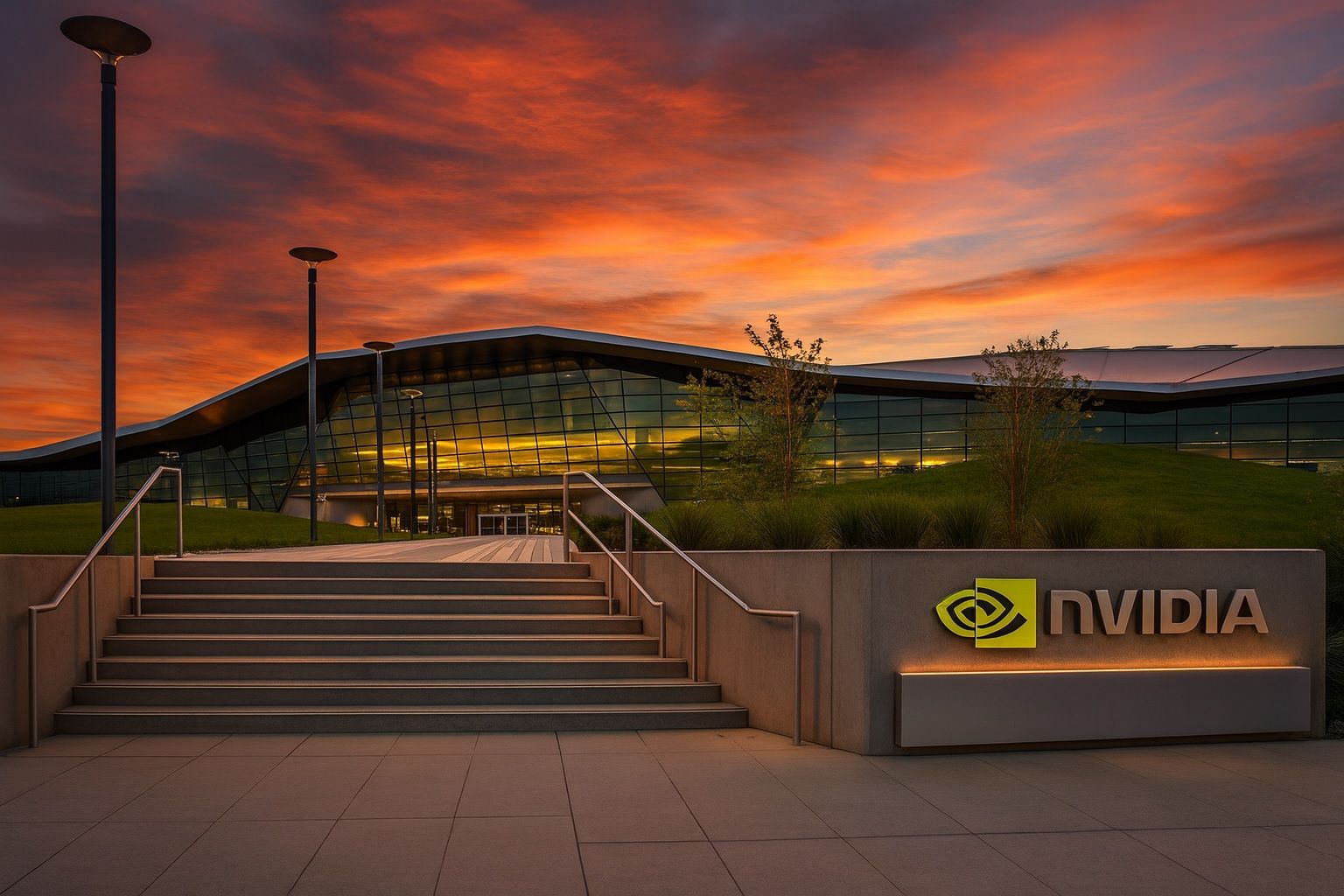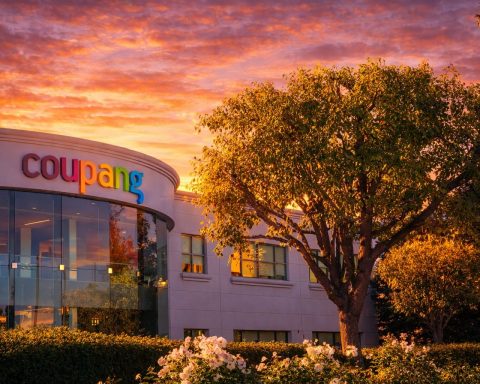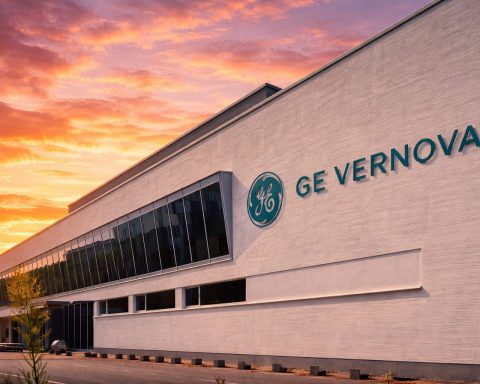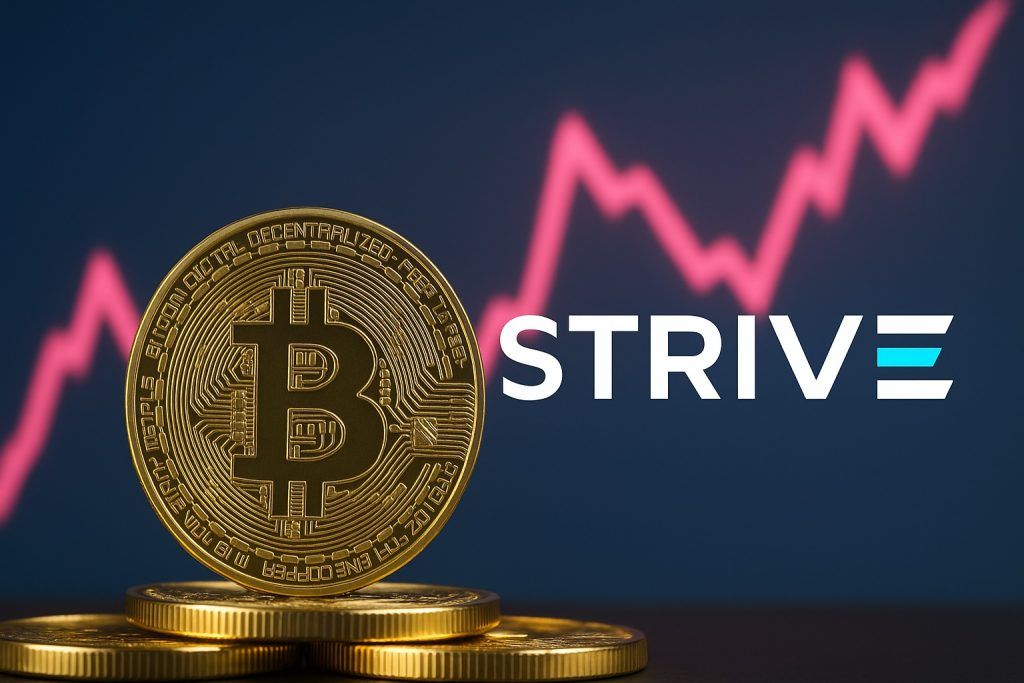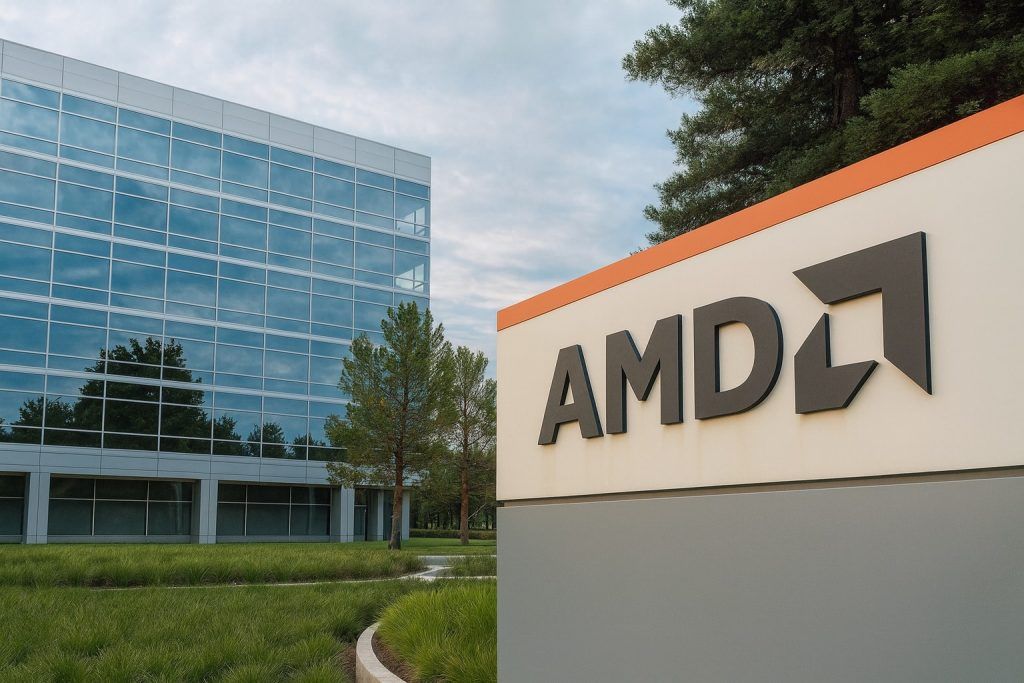- Near Record Price: Nvidia’s stock (NASDAQ: NVDA) is hovering around $186 per share – just shy of its all-time high (~$195) – valuing the AI chipmaker at roughly $4.4 trillion [1]. Shares have surged about 30% year-to-date (vastly outpacing the S&P 500) and are up ~58% from this time last year [2].
- AI Gold Rush Fuels Growth: Explosive demand for Nvidia’s GPUs (graphics chips) is driving staggering financial results. Revenue jumped 56% last quarter to $46.7 billion (FY2026 Q2) [3] – one of the fastest growth rates ever for a company of this size. Astonishingly, ~88% of that came from data-center AI chips [4]. “Jaw-dropping” profit margins (~72%) accompanied the boom, and investors briefly sent Nvidia’s market cap past $4.5 trillion in early October, making it the world’s most valuable company at the time [5].
- Mega AI Deals Secure Demand: Nvidia is capitalizing on the AI frenzy with unprecedented partnerships. It inked a $100 billion deal to supply OpenAI (maker of ChatGPT) with 10 GW of cutting-edge Nvidia GPUs [6], and OpenAI’s CEO Sam Altman enthused, “Everything starts with compute,” underscoring that Nvidia’s chips will power future AI breakthroughs [7]. Nvidia is also investing in Elon Musk’s new AI startup xAI – committing ~$2 billion toward xAI’s $20 billion supercomputer project [8]. In a historic twist, Nvidia even took a $5 billion stake in rival Intel to co-develop next-gen chips, and joined a $40 billion BlackRock-led consortium to acquire data centers for AI cloud capacity [9]. These alliances sparked euphoria – Nvidia’s stock leaped ~4% on the OpenAI news and another 2%+ on the xAI deal [10] – reflecting hopes of years of guaranteed AI hardware demand.
- Wall Street’s Verdict – Bullish Upside vs. Bubble Fears: The vast majority of analysts remain bullish. Over 90% of Wall Street analysts rate NVDA a “Buy” [11], with 12-month price targets averaging in the $210–$220 range [12] (about 15–20% above current levels). Some are even more upbeat – HSBC recently hiked its target to $320 (nearly 80% above today) [13], and one firm predicts Nvidia could eventually hit a staggering $10 trillion valuation [14]. However, not everyone is convinced. A lone contrarian, Jay Goldberg of Seaport Global, warns Nvidia’s lofty valuation (~50× earnings) leaves “little room for error” [15]. Goldberg – the only analyst with a Sell rating – argues “there’s a lot more that can go wrong… than can go right,” likening today’s AI hype to the dot-com bubble and setting a bleak $100 target on NVDA [16].
- Rivals & Risks: Nvidia’s dominance is attracting heavy competition. Rival AMD struck a deal to supply about 6 GW of AI chips to OpenAI starting in 2026 (even giving OpenAI an option to buy a 10% stake in AMD) [17]. AMD’s stock soared 34% in a day on that news [18], and other players are jumping in: Oracle plans to deploy 50,000 of AMD’s new GPUs in its cloud [19], and OpenAI is partnering with Broadcom to develop custom AI chips by 2026 [20]. While these moves validate the booming AI market, analysts say they won’t dethrone Nvidia’s lead – for now, Nvidia sells every AI chip it can produce to meet insatiable demand [21]. Another headwind is U.S.–China tech tension: Washington’s export curbs on advanced chips threaten an estimated 10–15% of Nvidia’s revenue [22]. Nvidia has rolled out modified China-only chips to comply with the rules, but Beijing retaliated by halting some Nvidia orders and scrutinizing shipments at customs [23]. Rumors of tighter U.S. restrictions have periodically rattled the stock [24]. On the bright side, officials granted some relief – approving exceptions for Nvidia’s new “H20” AI chip to be sold in China, and clearing a major AI chip order to the UAE [25] – slightly easing fears of a full China cutoff.
- Seasonal Strength – $200 in Sight?: NVDA may get an extra boost from timing. The company is entering one of its most historically favorable periods of the year, raising hopes that the stock could soon reach $200. Over the past 19 years, Nvidia shares have averaged an +8.1% gain with a ~71% win rate during this late-October to November stretch [26]. In fact, some of Nvidia’s strongest rallies often come in the fourth and fifth weeks of this seasonal phase [27]. With the stock already near record highs, this positive seasonality is adding fuel to bullish sentiment that NVDA might break above the $200 mark in the coming weeks [28].
- Next Catalyst – Earnings on Deck: All eyes are now on November 19, when Nvidia will report its next quarterly earnings (fiscal Q3 2026, for the quarter ending Oct. 27). Wall Street is bracing for another “blockbuster” report [29]. Nvidia itself guided to about $54 billion in quarterly revenue (≈54% year-over-year growth) [30], and analysts expect around $54.6 billion in revenue and $1.24 in adjusted EPS [31] – numbers many believe Nvidia can surpass. “Don’t sleep on Nvidia,” one analyst urged, reflecting optimism that the company will continue to defy gravity in this AI era [32]. Any sign that demand for AI chips is cooling could jolt the stock, given its rich valuation (NVDA trades around 50× forward earnings [33]). Conversely, a strong beat-and-raise on Nov. 19 might ignite the next leg of this rally – potentially putting that $300 target within reach [34]. But with Nvidia priced for perfection, even a slight “hiccup” in results or guidance could spur volatility [35].
NVDA Rides AI Boom to Historic Highs
Nvidia has been the poster child of the AI stock boom, and its recent performance reflects near-unprecedented optimism. In early October, NVDA briefly became the world’s most valuable publicly traded company when its market capitalization soared past $4 trillion [36] – a milestone no other company (not even Apple or Microsoft) had ever reached [37]. At its intra-month peak, Nvidia’s share price hit about $195.62 (an all-time high), valuing the company around $4.4–$4.5 trillion [38]. “It highlights that companies are shifting their spend in the direction of AI and it’s pretty much the future of technology,” one portfolio manager said of Nvidia’s $4T achievement [39].
Even after some profit-taking, Nvidia’s stock remains near record levels. It closed at $186 on Oct. 24 [40] and opened around $186.26 on Monday, Oct. 27 [41] – keeping within striking distance of its high. The stock has more than doubled from its 52-week low and gained roughly 35% in 2025 (≈58% year-over-year) [42] [43], vastly outperforming the broader market. This surge has made Nvidia the premier “AI play” on Wall Street. The company now accounts for over 7% of the S&P 500 by weight [44], meaning its daily swings can sway entire indexes. Heavy trading volumes and sharp moves have become the norm. In mid-October, for example, a spike in interest rates triggered a brief tech sell-off and NVDA tumbled ~4% in one day, only for dip-buyers to swiftly jump back in [45]. Such volatility underscores how “entrenched Nvidia has become in the AI narrative” [46] – each new AI breakthrough or major order can send the stock jumping, while any hint of slower growth sparks knee-jerk selloffs.
“AI Gold Rush” Drives Explosive Growth
The bullishness around Nvidia is rooted in eye-popping fundamentals. In its latest reported quarter (May–July 2025), Nvidia delivered $46.7 billion in revenue – up 56% year-on-year [47]. For a company already doing tens of billions in sales, that growth rate is almost unheard of. The driver? An AI gold rush that has data centers worldwide clamoring for Nvidia’s chips. Nearly $41 billion of the quarter’s revenue (≈88%) came from data-center products, chiefly the powerful GPUs used to train generative AI models [48]. In other words, the vast majority of Nvidia’s business is now tied directly to AI infrastructure, far eclipsing its legacy gaming graphics business.
This translated into “jaw-dropping” profits. Nvidia’s gross margins topped 72%, and net income jumped ~59% [49], showcasing tremendous operating leverage as demand vastly exceeds supply. Every high-end AI chip Nvidia makes is being snapped up by cloud providers, enterprises, and research labs racing to build advanced AI systems. As CEO Jensen Huang put it, demand for Nvidia’s newest AI platform has been “extraordinary,” delivering an “exceptional generational leap” in computing power [50] [51]. Little wonder, then, that investors have bid the stock to record heights.
Importantly, Nvidia insists this breakneck growth is far from over. On its last earnings call, management guided to roughly $54 billion in revenue for the current quarter (Aug–Oct 2025), which would be ~54% year-over-year growth [52] [53]. For a company of Nvidia’s size, sustaining ~50% growth at scale is astonishing – it underscores how acute the demand for AI hardware remains. Notably, Nvidia’s outlook excludes any potential sales to China (given U.S. export uncertainties) [54], meaning even without that sizable market the company is projecting meteoric growth. Many analysts expect Nvidia will beat these lofty forecasts. Wall Street consensus for the quarter is around $54.6 billion in revenue and $1.24 adjusted earnings per share [55], and some bullish observers think Nvidia could surprise to the upside yet again. The true test will come on Nov. 19, when Nvidia reports its results – a date already circled on every investor’s calendar.
Huge Deals Lock In Future Demand
Nvidia hasn’t been resting on its laurels amid its stock surge – instead, it’s been striking mega-deals to entrench its dominance in the AI industry. The most headline-grabbing was a deepening alliance with OpenAI, one of the world’s leading AI labs (and creator of ChatGPT). In late September, Nvidia and OpenAI announced a letter of intent for a partnership worth up to $100 billion [56]. Under this unprecedented deal, Nvidia will supply at least 10 gigawatts of its top-tier GPU systems over the coming years to power OpenAI’s next-generation AI supercomputers [57]. For context, analysts estimate that “every gigawatt of AI data center capacity is worth about $50 billion in revenue,” implying this tie-up could translate into hundreds of billions in future sales for Nvidia [58] [59]. The partnership blurs the line between vendor and investor: Nvidia also plans to invest up to $100 billion in OpenAI as these data centers are built [60]. OpenAI CEO Sam Altman highlighted the significance, saying “Everything starts with compute” – i.e. breakthroughs in AI require massive computing power, which Nvidia’s chips will provide [61]. Not surprisingly, Nvidia’s stock spiked ~4.4% on the news of the OpenAI deal [62], as investors cheered the securing of a customer that could drive years of demand.
Hot on the heels of OpenAI, Nvidia scored another victory with Elon Musk’s new AI venture, xAI. In October, news broke that xAI is raising a staggering $20 billion to build a giant AI supercomputer (dubbed “Colossus”), and Nvidia is not only the supplier but also a participant in the financing [63]. Nvidia is reportedly contributing up to $2 billion in equity for a stake in xAI’s project [64]. Essentially, Nvidia is helping fund its customer’s purchase of Nvidia hardware – a creative arrangement that ensures Musk’s startup uses Nvidia chips. When details emerged on Oct. 8, Nvidia’s stock jumped over 2% to near $189 [65]. Analysts viewed the xAI partnership as Nvidia “locking up” future demand, demonstrating that the company is willing to get innovative to secure its AI dominance [66] [67]. By tying itself into high-profile AI initiatives (even via financing deals), Nvidia is aiming to cement its GPUs at the heart of every major AI build-out for years to come.
The company has also forged other strategic alliances. In a surprising twist, Nvidia announced a partnership with its longtime rival Intel. In mid-September, Nvidia agreed to invest $5 billion in Intel and co-develop new chip technologies together [68]. This historic collaboration will see Intel manufacture certain Nvidia-designed chips and the two companies create tightly integrated CPU-GPU platforms for data centers [69] [70]. The idea is to combine Intel’s strengths in general-purpose processors with Nvidia’s prowess in AI accelerators, yielding hybrid systems that can run AI workloads even more efficiently. The market greeted this unlikely team-up warmly: Intel’s stock soared ~23% on the news, and Nvidia’s shares rose ~3.8% as well [71]. Analysts called it a “win-win” that bolsters Nvidia’s ecosystem while giving Intel a much-needed foothold in the AI chip race [72].
Beyond chips and partnerships, Nvidia joined forces with other tech giants and investors in an acquisition to expand AI infrastructure. It was part of a $40 billion consortium – alongside BlackRock, Microsoft, and others – that agreed to acquire Aligned Data Centers, adding 5 gigawatts of capacity for cloud AI computing [73]. And internationally, Nvidia partnered with firms like Fujitsu to build national AI infrastructure in Japan [74], underscoring its global ambition to be the backbone of the “AI industrial revolution.”
These moves all point to a common strategy: secure as much AI compute demand as possible, as early as possible. By locking in marquee customers (OpenAI, xAI), allying with potential rivals (Intel), and investing in the physical infrastructure of AI (data centers), Nvidia is fortifying its position at the center of the AI universe. Each deal has also served as a catalyst for the stock. The string of announcements through September and October contributed to Nvidia’s blockbuster month – fueling the hype that this $4+ trillion company could have even more room to run.
Bulls Bet on More Upside – But Skeptics Cite “Bubble” Risk
With Nvidia’s valuation skyrocketing, market opinion is split between exuberance and caution. On one hand, Wall Street’s consensus is overwhelmingly positive. According to Bloomberg data, 38 out of 47 analysts covering NVDA have a Buy rating (zero have Sell ratings aside from one outlier) [75]. The average 12-month price target sits in the low-$200s (around $210–$220 per share) [76], roughly 15–20% above current levels. Many analysts have been lifting their targets as Nvidia continues to beat expectations. For instance, HSBC recently raised its target to $320 [77] – nearly 80% higher than today’s price – citing Nvidia’s unparalleled leadership in AI. Some extremely bullish prognostications are even floating around: one investment firm speculated Nvidia could eventually become the first $10 trillion company if the AI revolution plays out fully [78]. As long as Nvidia keeps delivering torrid growth, bulls argue, the stock’s premium valuation is justified. Consensus estimates still call for ~34% revenue growth next fiscal year [79], a pace most companies can only dream of. In short, the believers see Nvidia as the foundational player of the AI era – a company riding a once-in-a-generation technological shift that is still in its early innings.
On the other hand, a few voices are warning that euphoria may be outpacing reality. At ~50× forward earnings [80], Nvidia’s stock price already bakes in a lot of future growth. Any stumble in execution or a slowdown in AI spending could lead to a painful correction. The most outspoken skeptic is Jay Goldberg of Seaport Global, currently the sole analyst with a “Sell” on NVDA. He argues that Nvidia’s valuation leaves “a lot more that can go wrong… than can go right” [81]. Goldberg likens the AI investment frenzy surrounding Nvidia to the dot-com bubble, cautioning that today’s breakneck AI spending by Big Tech might “tumble down” in a year or two if returns don’t materialize fast enough [82]. He has an outright bearish $100 price target [83] – implying the stock could fall nearly 50% – which stands in stark contrast to the rosy forecasts of his peers. While few share such a dire view, even moderates note that Nvidia’s expectations are sky-high. “Valuation leaves little room for error,” as another analyst put it [84]. Susquehanna’s Christopher Rolland, for example, remains positive long-term but cautions Nvidia might hit a “flat growth year” in the next couple of years that shocks investors used to endless expansion [85].
For now, the bulls clearly have momentum, but the bear case lurking in the background is that Nvidia could be too good to be true. The debate essentially boils down to whether Nvidia represents an extraordinary cornerstone of the AI revolution – a company whose growth justifies an unprecedented valuation – or whether even Nvidia will eventually come down to earth if the AI boom shows any sign of maturing. This tension between opportunity and risk makes Nvidia one of the most closely watched (and hotly debated) stocks on the planet.
Competition Heats Up in the AI Chip Race
One reason some are watching Nvidia warily is the emergence of credible competition in AI hardware. Nvidia’s current dominance – it commands an estimated 92% share of the AI accelerator market [86] – is being challenged as rivals and customers alike scramble to secure their own supply of AI chips.
The biggest challenger is Advanced Micro Devices (AMD), which is determined to grab a slice of the AI silicon boom. In early October, AMD announced a blockbuster agreement with OpenAI to provide roughly 6 gigawatts of AI GPU capacity starting in 2026 [87]. Uniquely, the deal even gives OpenAI an option to take a 10% ownership stake in AMD [88] – a sign of how badly OpenAI wants a non-Nvidia supplier. The market’s reaction showed that Nvidia isn’t the only game in town: AMD’s stock surged 34% in a single day on the news [89], its biggest one-day jump in nearly a decade. AMD’s upcoming MI300-series AI chips (set to launch in 2024–2025) are expected to be competitive alternatives for certain AI workloads, and big cloud players are starting to line up. Oracle, for instance, said it will deploy 50,000 of AMD’s MI300 GPUs in its cloud data centers by 2026 [90].
Other entrants are also seeking a foothold. OpenAI itself isn’t putting all its eggs in Nvidia’s basket – the AI lab is partnering with Broadcom to develop its own custom AI chips in-house, aiming for 10 GW of capacity by 2026 [91]. Tech giants like Google have long invested in proprietary AI processors (TPUs), and numerous startups are designing specialized AI chips. This flurry of activity underscores that the AI semiconductor market is enormous and expanding, potentially accommodating more than one winner.
Still, most experts believe Nvidia’s lead is safe for now. The company’s software ecosystem (CUDA), developer community, and years of optimization give it a competitive moat that newcomers struggle to match. As of this moment, demand far exceeds supply for Nvidia – it is effectively selling every high-end H100 GPU it can produce, with months-long backlogs. Thus, even if AMD or others chip away at certain deals, it may simply mean additional AI capacity rather than replacing Nvidia’s chips [92]. In fact, many view AMD’s recent wins as confirmation that AI adoption is so widespread that it’s “expanding the pie” for multiple players rather than knocking Nvidia off its perch [93]. So long as the total spending on AI continues to mushroom, Nvidia can continue to thrive even alongside rising competition.
That said, Nvidia will have to stay on its toes. The company is already preparing its next-generation “Blackwell” GPU for 2025, promising major performance gains to keep its edge [94]. It’s also extending into new areas like automotive AI, robotics, and even helping energy companies build “AI factories” (massive data centers for AI) [95]. Nvidia knows that in the tech world, today’s leader can become tomorrow’s laggard if they miss a beat – especially with deep-pocketed rivals aiming at them. The coming years will likely see a fierce battle for AI chip supremacy, but at least for the near term, Nvidia’s position appears solid. As one analyst quipped, “For now, Nvidia still sells every chip it can make” – a good problem to have [96].
Geopolitics and Other Wildcards
Beyond industry competition, Nvidia faces geopolitical and regulatory risks that could impact its trajectory. A significant one is the U.S.–China tech standoff. Nvidia has been caught in the crossfire of export restrictions as the U.S. government seeks to limit China’s access to advanced semiconductor technology. High-end Nvidia AI chips like the A100 and H100 have effectively been banned for export to China since late 2022 due to national security concerns. To continue serving the important Chinese market (previously 20%+ of its data center sales), Nvidia developed neutered versions (A800, H800) with lower performance to meet U.S. rules [97]. However, tensions ratcheted up further in 2023–2024. In September, China hit back by ordering its tech giants to halt purchases of Nvidia’s AI chips and even began delaying Nvidia shipments at customs [98] [99], accusing the company of monopolistic tactics. Then in October, reports surfaced that the U.S. might tighten the screws with even stricter chip export curbs, sending jitters through Nvidia’s stock [100].
These restrictions are not trivial – roughly 10–15% of Nvidia’s revenue (an estimated $5–$7 billion annually) could be at stake [101]. Losing the China market entirely would put a dent in Nvidia’s growth, at least in the short term. The company is lobbying U.S. officials to strike a balance that protects national security without cutting off American businesses from a huge customer base. There have been mixed signals so far. On one hand, U.S. authorities did grant some exemptions: for example, they approved a special Nvidia chip (the “H20”) that meets export limits for China, and gave a green light to a major Nvidia AI hardware order from the United Arab Emirates [102] [103]. These moves suggested the government isn’t trying to torpedo Nvidia’s foreign sales entirely. On the other hand, the situation remains fluid, and any escalation in U.S.–China tensions could weigh on Nvidia’s stock. Investors are keenly watching this geopolitical subplot; it introduces uncertainty that is hard to model, yet could materially impact Nvidia’s fortunes if relations worsen.
Another wildcard is the legal and regulatory scrutiny that often accompanies industry-leading success. For instance, Nvidia is facing a lawsuit from French auto supplier Valeo, which alleges a former Valeo engineer stole self-driving tech secrets and brought them to Nvidia; the case is headed to trial in November [104]. While such cases are a footnote compared to the big-picture drivers, they highlight that Nvidia’s rapid ascent comes with increased scrutiny on multiple fronts (IP, antitrust, etc.). Thus far, nothing has emerged that poses an existential threat, but it’s a reminder that Nvidia operates under a bright spotlight.
Looking Ahead: Can Nvidia Keep Defying Gravity?
As October 2025 draws to a close, Nvidia finds itself at a pivotal moment. The company’s stock has already achieved dizzying heights, yet many believe the best is still to come. In the near term, the focus is squarely on earnings. Nvidia’s Q3 results on Nov. 19 will show whether the company is continuing its trend of smashing expectations or if the torrid growth is finally moderating. Given Nvidia’s own bullish forecast (54% YoY growth) and the massive deals inked this quarter, most analysts anticipate another strong beat. “Wall Street expects another ‘blockbuster’ report,” notes TS² Tech, with sentiment remaining “optimistic that Nvidia will continue defying gravity” [105] [106]. Any positive surprise in the earnings or outlook could serve as a catalyst to drive NVDA higher into year-end. Some bulls are watching for the stock to breach the $200 threshold in the coming weeks – a level it has never closed above – and then make a run toward the mid-$200s or even that psychological $300 mark if AI momentum stays red-hot.
However, expectations are undeniably high. Nvidia is now priced for perfection, and investors are acutely sensitive to any cracks in the story. If data center AI demand were to slow sooner than expected, or if supply constraints/competition started eroding Nvidia’s growth, the stock could react violently. The sheer valuation means small misses can lead to big swings. “Investors are bracing for volatile trading around the results,” TS² Tech observes, given how much optimism is baked in [107]. A big earnings “beat-and-raise” could indeed confirm the bull thesis and embolden those calling for $300 [108]. But a hiccup – say, growth “only” in the 40–45% range, or cautious guidance – might trigger a sharp sell-off from these heights [109].
Beyond this quarter, the longer-term narrative for Nvidia hinges on the broader AI revolution. Almost every trend – from cloud computing and autonomous vehicles to robotics and the metaverse – ties back to the need for advanced AI computation, which plays to Nvidia’s strengths. “The AI revolution is just beginning,” CEO Jensen Huang reminds stakeholders, and by all accounts Nvidia intends to remain at its forefront [110]. The company’s challenges (competition, geopolitics, valuation) are real, but so are its advantages (technology leadership, ecosystem, execution track record). As one analyst succinctly put it: “Don’t sleep on Nvidia.” [111] In other words, love it or hate it, Nvidia has established itself as a central pillar of the tech world’s future. For investors and onlookers alike, the coming weeks will be crucial to see if this AI titan can keep living up to its sky-high expectations – or if gravity will finally start to take hold.
Sources: NVIDIA financial reports and earnings guidance; TS² Tech analysis [112] [113] [114]; Reuters and Bloomberg news on Nvidia’s market cap milestones [115]; Finbold market insights [116] [117]; MarketBeat institutional holdings data [118] [119]; Analyst commentary via Motley Fool and Cryptopolitan [120]; Nvidia and OpenAI partnership announcements [121]; AMD and Broadcom AI chip deals via Reuters [122]; U.S.–China export policy updates [123].
References
1. ts2.tech, 2. ts2.tech, 3. ts2.tech, 4. ts2.tech, 5. ts2.tech, 6. ts2.tech, 7. ts2.tech, 8. ts2.tech, 9. ts2.tech, 10. ts2.tech, 11. ts2.tech, 12. ts2.tech, 13. ts2.tech, 14. ts2.tech, 15. ts2.tech, 16. ts2.tech, 17. ts2.tech, 18. ts2.tech, 19. ts2.tech, 20. ts2.tech, 21. ts2.tech, 22. ts2.tech, 23. ts2.tech, 24. ts2.tech, 25. ts2.tech, 26. finbold.com, 27. finbold.com, 28. finbold.com, 29. ts2.tech, 30. ts2.tech, 31. finbold.com, 32. ts2.tech, 33. ts2.tech, 34. ts2.tech, 35. ts2.tech, 36. ts2.tech, 37. ts2.tech, 38. ts2.tech, 39. ts2.tech, 40. ts2.tech, 41. www.marketbeat.com, 42. ts2.tech, 43. ts2.tech, 44. ts2.tech, 45. ts2.tech, 46. ts2.tech, 47. ts2.tech, 48. ts2.tech, 49. ts2.tech, 50. ts2.tech, 51. ts2.tech, 52. ts2.tech, 53. finbold.com, 54. ts2.tech, 55. finbold.com, 56. ts2.tech, 57. ts2.tech, 58. ts2.tech, 59. ts2.tech, 60. ts2.tech, 61. ts2.tech, 62. ts2.tech, 63. ts2.tech, 64. ts2.tech, 65. ts2.tech, 66. ts2.tech, 67. ts2.tech, 68. ts2.tech, 69. ts2.tech, 70. ts2.tech, 71. ts2.tech, 72. ts2.tech, 73. ts2.tech, 74. ts2.tech, 75. ts2.tech, 76. ts2.tech, 77. ts2.tech, 78. ts2.tech, 79. ts2.tech, 80. ts2.tech, 81. ts2.tech, 82. ts2.tech, 83. ts2.tech, 84. ts2.tech, 85. ts2.tech, 86. finbold.com, 87. ts2.tech, 88. ts2.tech, 89. ts2.tech, 90. ts2.tech, 91. ts2.tech, 92. ts2.tech, 93. ts2.tech, 94. ts2.tech, 95. ts2.tech, 96. ts2.tech, 97. ts2.tech, 98. ts2.tech, 99. ts2.tech, 100. ts2.tech, 101. ts2.tech, 102. ts2.tech, 103. ts2.tech, 104. ts2.tech, 105. ts2.tech, 106. ts2.tech, 107. ts2.tech, 108. ts2.tech, 109. ts2.tech, 110. ts2.tech, 111. ts2.tech, 112. ts2.tech, 113. ts2.tech, 114. ts2.tech, 115. ts2.tech, 116. finbold.com, 117. finbold.com, 118. www.marketbeat.com, 119. www.marketbeat.com, 120. ts2.tech, 121. ts2.tech, 122. ts2.tech, 123. ts2.tech
